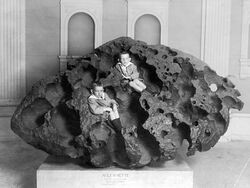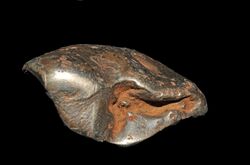Earth:Meteorite weathering
Meteorite weathering is the terrestrial alteration of a meteorite. Most meteorites date from the oldest times in the Solar System and are by far the oldest material available on our planet. Despite their age, they are vulnerable to the terrestrial environment. Water, chlorine and oxygen attack meteorites as soon as they reach the ground.
Weathering scales
In order to quantify the degree of alteration that a meteorite experienced, several qualitative weathering indices have been applied to antarctic and desert samples.[1]
The most known weathering scale is based upon the effects seen in polished thin sections of chondritic meteorites and it ranges from W0 (pristine) to W6 (heavy alteration). It was proposed by Jull A. J. T. et al.[2] (1991) and updated by Wlotzka[3][4](1993) and Al-Kathiri et al.[5](2005).
- W0: no visible oxidation of metal or troilite, but may be noticeable in transmitted light a limonitic staining. Usually recently fallen meteorites are of this grade, although some are already W1.
- W1: small oxide rims around metal and troilite, small oxide veins.
- W2: moderate oxidation of metal (about 20-60% replaced).
- W3: heavy oxidation of metal and troilite (60-95% replaced).
- W4: complete oxidation of metal and troilite (>95% replaced), but no alteration of silicates.
- W5: beginning alteration of mafic silicates, mainly along cracks.
- W6: heavy replacement of silicates by clay minerals and oxides.
The Meteorite Working Group at the Johnson Space Center uses weathering categories A B, C and E to denote the alteration of antarctic meteorites.[1] Their official definitions are:[6]
- A: Minor rustiness; rust haloes on metal particles and rust stains along fractures are minor.
- B: Moderate rustiness; large rust haloes occur on metal particles and rust stains on internal fractures are extensive.
- C: Severe rustiness; metal particles have been mostly stained by rust throughout.
- E: Evaporite minerals visible to the naked eye.
See also
- Glossary of meteoritics
- Meteorite classification
- Weathering
References
- ↑ Jump up to: 1.0 1.1 P. A. Bland, M. E. Zolensky, G. K. Benedix, M. A. Sephton. "Weathering of Chondritic Meteorites"
- ↑ Jull, A. J. T.; Wlotzka, F.; Donahue, D. J. (1991). "Terrestrial Ages and Petrologic Description of Roosevelt County Meteorites". Abstracts of the Lunar and Planetary Science Conference 22: 667. Bibcode: 1991LPI....22..667J.
- ↑ Wlotzka, F. (1993). "A Weathering Scale for the Ordinary Chondrites". Meteoritics 28: 460. Bibcode: 1993Metic..28Q.460W.
- ↑ Wlotzka, F.; Jull, A. J. T.; Donahue, D. J. (1995). "Carbon-14 Terrestrial Ages of Meteorites from Acfer, Algeria". Workshop on Meteorites from Cold and Hot Deserts: 72. Bibcode: 1995mfch.work...72W.
- ↑ Al-Kathiri, A.; Hofmann, B. A.; Jull, A. J. T.; Gnos, E. (2005). "Weathering of meteorites from Oman: Correlation of chemical and mineralogical weathering proxies with14C terrestrial ages and the influence of soil chemistry". Meteoritics & Planetary Science 40 (8): 1215–1239. doi:10.1111/j.1945-5100.2005.tb00185.x. Bibcode: 2005M&PS...40.1215A.
- ↑ "Meteorite Weathering Categories". http://curator.jsc.nasa.gov/antmet/amn/weather.htm.
 |



